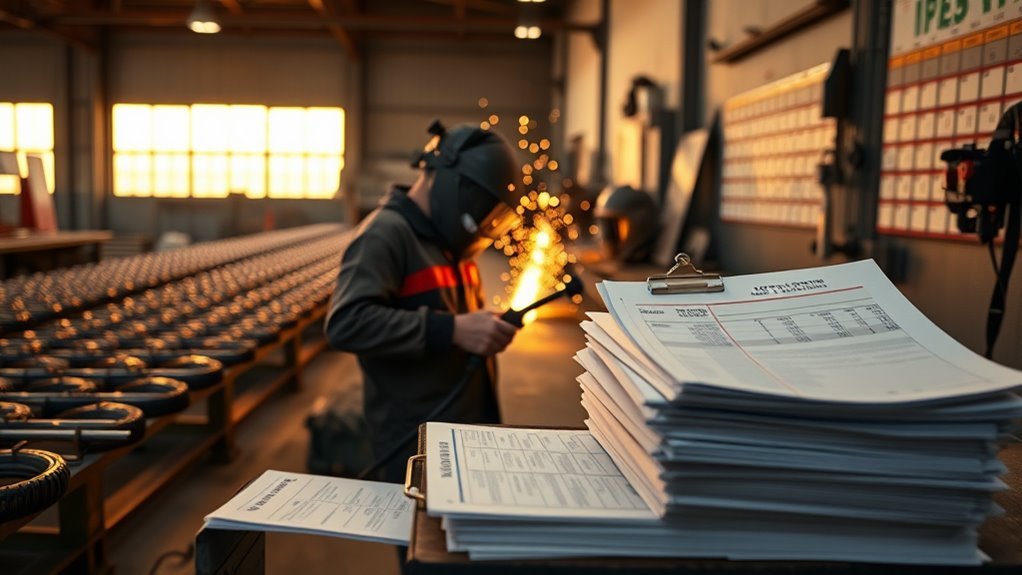Welding school costs vary but you’ll typically pay between about $3,000 and $25,000 depending on program length and school type. Short certificate courses run roughly $3–10K, year‑long diplomas $5–15K, and two‑year associate degrees $10–25K. Add $500–1,500 for personal tools and PPE, plus certification fees of $300–550 each. Financial aid, apprenticeships, and employer help can cut your outlay, and the next sections explain how to optimize costs and funding.
Average Tuition Costs for Welding Programs

While costs vary by program length and credential, you can expect to pay roughly $5,000 to $15,000 for most welding programs, with advanced options sometimes topping $20,000.
Expect most welding programs to cost roughly $5,000–$15,000, with advanced options occasionally exceeding $20,000.
You’ll see certificate programs from about $3,000 to $10,000 for short, focused training; diploma programs run nearer $5,000 to $15,000 for roughly a year; associate degrees generally sit between $10,000 and $25,000 for two years; bachelor’s tracks can leap to $40,000–$100,000 when they add business or engineering coursework.
When you do tuition comparisons, match program length, credential level, and included equipment or materials.
That keeps program affordability realistic and lets you judge value rather than sticker price, so your decision rests on outcomes, not just costs.
Types of Schools and How They Affect Price

Because the school you choose shapes both the price and what you get for it, you should weigh institution type alongside tuition when comparing programs.
You’ll find welding school types include trade schools, community colleges, certificate and diploma programs, and associate-degree tracks, each with distinct tuition factors.
Trade schools emphasize hands-on skills and generally charge $5,000–$20,000. Community colleges average about $5,000 for two-year programs and often bundle general education with shop time.
Certificate courses run weeks to months and cost $3,000–$10,000, while diplomas typically cost $5,000–$15,000. Associate degrees may reach $10,000–$25,000.
Class size, shop hours, and instructor experience materially affect your cost and the value you receive, so compare offerings, not just price.
Program Lengths and Their Cost Differences

When you compare certificate, diploma, and associate degree paths, you’ll see shorter programs usually cost less upfront while longer degrees add tuition and time.
Certificates can run a few weeks to months for roughly $3,000–$10,000, diplomas about a year at $5,000–$15,000, and associate degrees two years at $10,000–$25,000.
Consider that specialty or advanced training (like underwater welding) often costs more and can extend the timeline beyond standard programs.
Certificate vs. Degree
If you want fast entry into welding, certificate and diploma programs get you on the shop floor in weeks to a year and typically cost between about $3,000 and $15,000.
Associate and bachelor’s degrees take longer—two to four years—add general education or business/engineering courses, and can range from roughly $10,000 up to $100,000.
You’ll choose certificates or diplomas for focused, hands-on training that emphasizes welding career readiness and immediate program outcomes like basic qualifications and industry-recognized skills.
An associate degree adds general education and broadens job prospects with more technical depth; costs usually fall between $10,000 and $25,000.
Bachelor’s programs extend training into management or engineering areas, raise costs substantially, and suit those targeting supervisory, design, or specialist roles.
Short vs. Long Programs
Although program length affects what you learn and what you pay, shorter welding tracks get you into the shop faster while longer programs broaden your opportunities.
You’ll see certificate programs that last weeks to months and cost $3,000–$10,000; they emphasize skill specialization so you can start earning quickly.
Diploma programs run about a year ($5,000–$15,000), giving more hands-on time.
Associate degrees require roughly two years ($10,000–$25,000), balancing shop work with general education.
If you pursue a bachelor’s, expect four years and $40,000–$100,000, with broader engineering or business coursework.
Match program duration to your career plan: pick short for immediate entry-level roles, longer for advancement, supervision, or specialized technical paths.
Required Tools, Gear, and Supply Expenses

Expect to spend between about $500 and $1,500 on core tools and safety gear for welding school, with choices you make about quality and type driving the final cost.
Expect to invest roughly $500–$1,500 in essential tools and safety gear for welding school.
You’ll need required equipment: a helmet, gloves, jacket, boots, chisels, pliers, and basic hand tools.
Decide whether to buy a personal welding machine—budget $500 to $2,000 if you plan to own one; otherwise use school machines.
Plan additional supplies: consumables, practice materials, and books, typically $100–$500 more.
Use practical budgeting strategies: prioritize safety gear first, buy mid-range tools that last, and shop used for noncritical items.
Expect to set aside an extra $100–$500 for consumables during training so you won’t be caught short.
Certification and Testing Fees to Budget For

Budget for certification exams, which commonly run $300–$550 each and often aren’t included in tuition.
You’ll also need to plan for recertification or retest fees, and remember specialized credentials (like underwater welding) can cost more.
Check whether your program covers preparation and testing so you can estimate the total outlay and decide how many credentials to pursue.
Certification Exam Costs
Someone entering a welding program should plan for certification exam fees, which typically run $300–$550 per test and often aren’t included in tuition.
You should factor certification relevance into your budget and prioritize exam preparation to guarantee you pass the right tests for your chosen specialty.
Consider these points:
- Budget $300–$550 per exam; multiple tests may be needed for different techniques.
- The American Welding Society Certified Welder exam is widely recognized and often required by employers.
- Ask your school about scholarships or financial assistance that can offset testing costs.
- Include test fees in your total cost estimate so you won’t be surprised when scheduling certifications.
This keeps your plan realistic and aligned with hiring expectations.
Recertification and Retests
Because welding credentials expire and employers often require up-to-date proof, you should plan for recurring recertification and possible retest fees as part of your long-term budget.
Certification tests commonly cost $300–$550 each, and those expenses may not be included in tuition. Expect to pay recertification fees every few years depending on the credential and governing body.
If you fail an initial exam, some programs charge additional fees for retesting, so ask about available retesting options and costs up front.
Verify whether your school offers preparation resources or discounted retest vouchers—these can reduce repeat expenses.
Keep a calendar of renewal dates and documented costs so you stay compliant and maintain employability without unexpected financial surprises.
Living, Travel, and Miscellaneous Costs During Training
When you factor in housing, food, transportation and the little extras that add up, expect living expenses during welding school to run roughly $5,000–$15,000 per academic year depending on where you live and how you choose to live.
You’ll want clear budgeting strategies and cost saving tips from day one: track monthly rent, groceries, utilities, and incidentals. Commuting or off-site training raises travel costs; factor gas, transit passes, or occasional lodging into your plan.
Personal tool upkeep or replacement is a predictable miscellaneous expense. Prioritize essentials, build a small repair fund, and cut nonessential entertainment.
- Housing and utilities
- Transportation and travel
- Food and personal items
- Equipment maintenance and replacement
Financial Aid, Grants, and Scholarship Options
You’re not starting from scratch: federal grants and trade-school scholarships can cover a large portion of tuition without repayment.
Check with your program and organizations like the American Welding Society for school-specific awards, and ask whether your chosen trade school participates in federal aid.
Also explore employer-sponsored training and union assistance, which can supplement grants and loans to make the program affordable.
Federal Grants Available
Curious how much federal aid can lower your welding-school bill? You’ll find federal grant types and eligibility criteria matter most: grants don’t require repayment and many welding schools participate in the Federal Financial Aid Program, so you can access funds if you qualify.
Research and apply early.
- Pell Grant — need-based, often the largest federal award for eligible students.
- Other federal grants — smaller programs may help depending on your situation and enrollment status.
- School participation — confirm your school accepts federal aid to guarantee grant access.
- Combine funds — pair federal grants with scholarships and loans to build a full aid package and reduce out-of-pocket costs.
Trade School Scholarships
Looking for ways to cut the cost of welding school? You can combine scholarship eligibility, grants, and loans to reduce out‑of‑pocket expenses. Professional associations like the American Welding Society offer scholarships based on skill, need, or merit. Many trade schools, such as MTI, provide targeted awards for high school seniors. Grants don’t require repayment, and federal student loans provide lower interest and flexible repayment when you need extra funding. Explore multiple funding sources, apply early, and confirm criteria to maximize aid. The right mix of scholarships, grants, and loans can make training affordable and keep debt manageable.
| Source | Typical Criteria | Benefit |
|---|---|---|
| Associations | skill/merit | targeted aid |
| Schools | enrollment/senior | tuition offset |
| Grants | need-based | no repayment |
| Loans | FAFSA | flexible terms |
Employer & Union Aid
After exhausting scholarships, grants, and loans, consider employer and union programs as another reliable funding path for welding school.
You can tap employer sponsorships and union funding to lower costs, often with tuition reimbursement, paid apprenticeships, or training partnerships. Vet offers carefully: check service commitments, wage adjustments, and what’s covered.
- Ask current or prospective employers about tuition reimbursement and paid on-the-job training.
- Contact local trade unions for apprenticeship slots and union funding for classes and tools.
- Combine employer sponsorship with grants or the GI Bill® to cover remaining expenses.
- Review federal loan terms only after employer aid and grants are maximized.
These options often provide practical, low-cost routes into a welding career.
Payment Plans, Loans, and Veteran Benefits
If you need flexibility to manage tuition, many welding schools break costs into smaller payment plans—often in 7- or 10-week increments—so you can spread out payments instead of paying a lump sum.
You’ll find payment plans that match course schedules and reduce upfront strain, and it’s wise to ask about loan eligibility early so you know which federal or private options the school accepts.
Some campuses participate in Title IV and federal loan programs, offering lower interest and predictable repayment; others don’t.
Veterans should verify GI Bill® benefits and VA certification at the school; many institutions also accept WIOA and similar funding.
Finally, pursue scholarships and grants from trade groups or employers to cut your net cost before borrowing.
Comparing Return on Investment by Industry and Location
How much return you get from welding school depends heavily on the industry you enter and the region where you work. You’ll weigh program cost against median wages (about $47,540 in 2022) and sector variance: oil and gas pays more, boosting ROI.
Locations with strong welding job markets, like Texas or Alaska, typically offer higher pay and steadier employment because of local industry demand. Certifications from the American Welding Society raise your earning potential and employability, improving returns.
Locations with strong welding markets, such as Texas or Alaska, offer higher pay and steadier work; AWS certifications further boost earnings.
- Lower-cost programs ($2,800–$15,000) → quicker entry, faster payback.
- High-paying industries → larger lifetime earnings.
- Regional demand → better job prospects and negotiating power.
- Specialized certs → higher starting wages and mobility.
Tips to Lower Your Welding School Expenses
While choosing the right program won’t guarantee free schooling, you can cut your total cost substantially by prioritizing community colleges or accredited trade schools, applying early for scholarships and grants, and confirming federal financial aid eligibility before enrolling. You should run welding program comparisons to spot programs in the $5,000–$15,000 range versus private options over $20,000. Hunt scholarship and grant funding sources from associations and employers, and use school payment plans to spread costs. Don’t forget tools, safety gear, and certification tests ($500–$1,500). Choose schools with federal aid participation to access low‑interest loans when needed, and prioritize accredited programs that balance price, quality, and credential value.
| Strategy | Typical Cost Impact | Action |
|---|---|---|
| Community college | – | Compare tuition |
| Scholarships/grants | Lowers tuition | Apply early |
| Payment plans | Improves cashflow | Enroll options |
| Tools & tests | $500–$1,500 | Budget ahead |
| Federal aid | Access loans | Verify eligibility |
Frequently Asked Questions
Can I Work Part-Time While Attending Welding School?
Yes — you can work part-time while attending welding school; many programs offer welding school flexibility with evening or weekend classes, so you’ll balance part time employment, hands-on training, and study without sacrificing progress or safety.
Are Online Welding Courses Accepted by Employers?
Yes — sort of. You’ll find online course credibility varies, and employers prefer hands‑on proof; many accept hybrid certificates when employers see solid skills, reputable instructors, and documented practical experience that matches employer preferences.
Do Welding Schools Provide Job Placement Assistance?
Yes — many welding schools provide job placement assistance; you’ll get job support and career counseling, resume help, interview prep, and employer connections. You’ll be guided patiently and precisely toward realistic, achievable employment opportunities.
What Safety Certifications Are Required Before Enrollment?
You typically won’t need pre-enrollment safety training, but you’ll need to complete the certification process during your program; schools’ll expect basic PPE knowledge, respirator fit tests or OSHA 10/30 credentials depending on course and employer requirements.
Are Tool Discounts Available for Students Through Schools?
Yes — many schools offer tool discounts and student savings through partnerships, campus stores, or kit deals; you’ll get guidance on eligible vendors, coupon codes, and timing so you can buy quality tools affordably and efficiently.
Conclusion
So you’re weighing welding school costs — congratulations, you’re investing in sparks and future paychecks. Expect tuition from modest community-college prices to eyebrow-raising private programs, plus gear, cert fees, and the occasional “surprise” supply list. Hunt scholarships, VA benefits, and payment plans like a prospector for gold; ROI depends on trade, location, and grit. Choose wisely, practice relentlessly, and enjoy the satisfying clang of a chosen craft turning into a steady living.


